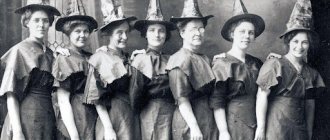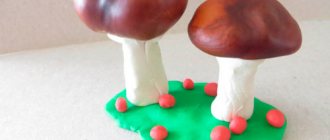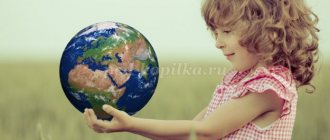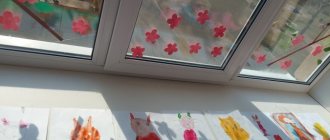Program "Childhood".
Respectful attitude towards the crafts of the native land, towards the artistic heritage of Russia. Showing interest in creative work. Expression of preferences.
Visiting of museum.
The idea of a museum as a treasury of values and works of art. Exhibits and collection. Interest in visiting museums, galleries; knowledge and desire to comply with the rules of conduct in the museum.
Development of productive activity and children's creativity
Objectives of educational activities:
Develop children's visual activity: independent determination of the concept of future work, the desire to create an expressive image, the ability to independently select impressions and experiences to determine the plot, select visual techniques and materials appropriate to the image, plan activities and achieve results, evaluate them, interact with other children in the process of collective creative works. Develop technical and visual-expressive skills.
To support the personal manifestations of older preschoolers in the process of mastering art and their own creative activity: independence, initiative, individuality, creativity.
Continue to develop emotional, aesthetic, creative, sensory and cognitive abilities.
Contents of educational activities
Development of skills to determine the intention of future work, independently select impressions and experiences to determine the plot, create an expressive image and convey one’s attitude.
Showing initiative in artistic and playful activities, expressing one’s own aesthetic judgments and assessments.
Development of skills to plan activities, bring work to results, and evaluate them; use materials economically. Introducing how to create a sketch. Ability to draw the outline of an object with a simple pencil. Mastering new, more complex ways of creating images.
Creating images from imagination, memory, from nature; the ability to analyze an object, properties, establish spatial, proportional relationships, and convey them in work.
Visual and expressive skills
Continued development of skills to highlight the main thing using adequate means of expression.
The use of color as a means of conveying mood, state, attitude towards the image or highlighting the main thing in the picture; properties of color (warm, cold range), beauty, brightness of saturated or muted tones. Ability to subtly distinguish shades (developed color perception). Ability to select paper backgrounds and color combinations. Development of skills to convey the variety of forms, textures, proportional relationships. In the depiction of the objective world: and convey similarities with real objects; when depicting from life, convey the characteristic and individual characteristics of objects and living objects; when depicting fairy-tale images, convey signs of unusualness; in a plot image, convey the relationships between objects, using all means of expressiveness and composition: depict objects in close, middle and distant plans, draw the horizon line; in a decorative image
create elegant, generalized images; decorate objects with ornaments and patterns, using rhythm and symmetry in compositional structure; decorate flat and three-dimensional shapes, object images and geometric bases.
Long-term planning of educational activities in the senior group (according to the “Childhood” program)
| 26.03.15 | Road safety | V.N. Volchkova p.182 |
| 30.03.15 | Plants are the lungs of the Earth | V. N. Volchkova p.84 |
| 06.04.15 | How to behave at the circus? | V.N. Volchkova p.145 |
| 09.04.15 | Nature of the native land | abstract |
| 13.04.15 | Where do plants like to live? | V.N.Volchkova p.87 |
| 20.04.15 | Who shoes and dresses us? | V.N. Volchkova p.33 |
| 23.04.15 | Poisonous mushrooms and berries | V.N. Volchkova p.198 |
| 27.04.15 | Who enjoys spring the most? | V.N. Volchkova p.97 |
| 07.05.15 | Travel along the Kuban River | T.P. Khlopova p.69 |
| 18.05.15 | Artificial materials are needed | V. N. Volchkova p.98 |
| 21.05.15 | Safety in nature | V.N. Volchkova p.195 |
| 25.05.15 | Earth is our common home | V.N. Volchkova p.119 |
Bibliography.
Mathematics. Senior group. Lesson developments. Parts I and IIAuthor: Zhukova R.A. Publisher: ITD "Corypheus" 2009
Volchkova V.N., Stepanova N.V.: Lesson notes for the senior group of kindergarten. Speech development. Practical guide for educators and methodologists of preschool educational institutions. - Voronezh: TC “Teacher”, 2006
D.G. Shumaeva: How to be able to read well: Teaching preschoolers to read: Program summary. St. Petersburg: Aksident, 1998
Volchkova V.N., Stepanova N.V.: Lesson notes for the senior group of kindergarten. Cognitive development. Practical guide for educators and methodologists of preschool educational institutions. - Voronezh: TC “Teacher”, 2008
Volchkova V.N., Stepanova N.V.: Lesson notes for the senior group of kindergarten. Ecology. Practical guide for educators and methodologists of preschool educational institutions. - Voronezh: TC “Teacher”, 2008.
Volchkova V.N., Stepanova N.V.: Lesson notes for the senior group of kindergarten. ISO. Practical guide for educators and methodologists of preschool educational institutions. - Voronezh: TC “Teacher”, 2008
Ushakova O.S., Gavrish N.V. We introduce literature to children aged 5-7 years. Lesson notes.- M.: TC Sfera, 2010.-224 p.- (Speech development).
A collection of articles and materials dedicated to the anniversary of the village of Temizhbekskaya. 200 years of the village of Temizhbek.
Lykova I.A. Visual activities in kindergarten: planning, notes, classes, methodological recommendations. Senior group. - M.: Karapuz-Didaktik, 2007.
Lyudmila Kutsakova: Design and artistic work in kindergarten: Program and lesson notes Publisher: Sfera, 2008
E. Gulyants, I. Bazik, What can be made from natural materials Publisher: Moscow “Prosveshcheniye” Year: 1991
Irina Novikova: Paper construction in kindergarten. Publisher: Academy of Development, 2010
N.N. Leonova Artistic and aesthetic development of children in the senior group of preschool educational institutions. Long-term planning, notes. - St. Petersburg: Publishing House “Childhood-Press” LLC, 2014
T.M. Bondarenko: Complex classes in the senior group of kindergarten. Practical guide for educators and methodologists of preschool educational institutions. - Voronezh: TC “Teacher”, 2007
“Childhood” program age characteristics of children from 4 to 5 years old
Program "CHILDHOOD"
Age characteristics of children from 4 to 5 years old
The physical capabilities of children have increased: their movements have become much more confident and varied. Preschoolers have an urgent need to move. If active motor activity is limited, they quickly become overexcited, become disobedient, and capricious.
Children actively demonstrate a desire to communicate with peers. Their verbal contacts become more effective and efficient. Preschoolers 4-5 years old willingly cooperate with adults in practical matters, but at the same time they are increasingly striving for cognitive, intellectual communication. The age of “why” is manifested in numerous questions from children to the teacher: “Why?”, “Why?”, “For what?” The child's developing thinking, the ability to establish the simplest connections and relationships between objects awaken a wide interest in the world around him.
The child is able to analyze objects simultaneously according to 2-3 characteristics: color and shape, color, shape and material, etc.
Children aged 4-5 years clearly show interest in the game. The game becomes more complex in content, number of roles and role-playing dialogues. A notable feature of children is their imagination; they often confuse fiction and reality. Children of this age are experiencing an awakening interest in the rules of behavior.
Children are actively developing and maturing their emotional sphere: feelings become deeper and more stable; the previous joyful feeling from communicating with others gradually develops into a more complex feeling of sympathy and affection. In the fifth year of life, awareness of one’s gender begins. Children note the external differences between boys and girls.
Children's vocabulary increases to 2000 words or more. In conversation, the child begins to use complex phrases and sentences.
Planned intermediate results of children's mastery of the basic general education program of preschool education.
Middle group (5 years)
By the age of five, with successful completion of the Program, the following level of development of the child’s integrative qualities is achieved:
Physically developed, mastered basic cultural and hygienic skills.
Anthropometric parameters (height, weight) are normal. Physical capabilities have increased significantly: movements have become much more confident and varied. Experiences an urgent need to move and is highly excitable. If active motor activity is limited, he becomes overexcited, disobedient, and capricious. Emotionally charged activities become not only a means of physical development, but also a way of psychological relief for children of middle preschool age. Performs age-appropriate hygienic procedures and follows basic rules of a healthy lifestyle. Talks about the sequence and necessity of performing cultural and hygienic skills - dressing for a walk, eating and using cutlery, using personal hygiene items. He is independent in self-care, sets goals himself, sees the need to perform certain actions.
Curious, active.
He is highly active and inquisitive. Asks a lot of searching questions: “Why?”, “Why?”, “For what?”. Strives to establish connections and dependencies in nature and the social world. Masters the basic methods of cognition, has some experience in activities and a stock of ideas about the environment, and with the help of the teacher is actively involved in experimentation activities. In the process of joint research activities, actively learns and names the properties and qualities of objects, features of natural objects, and research activities. Unites items and objects into specific categories indicating characteristic features.
Emotionally responsive
. Responds to the emotions of loved ones and friends. To attract and maintain the attention of a peer, he uses means of intonational speech expressiveness - voice strength, intonation, rhythm and tempo of speech. He reads poetry expressively, retells short stories, conveying his attitude towards the characters. Uses words of participation, emotional sympathy, and compassion in speech to maintain cooperation and establish relationships with peers and adults. Using figurative language, he conveys the emotional states of people and animals. Experiences joy from communicating with animals and plants, both familiar and new to him. Empathizes with fairy tale characters. Reacts emotionally to works of art and the natural world.
Mastered the means of communication and ways of interacting with adults and peers.
Actively demonstrates a desire to communicate with peers. Needs meaningful contacts with peers about toys, joint games, and common affairs. Speech contacts become longer and more active, and the first friendly connections between children are established. At the suggestion of the teacher, he can agree with a peer about playing together, select the necessary toys, and create a play environment. Strives for self-expression in activities, recognition and respect of peers. Willingly cooperates with adults not only in practical matters (joint games, work assignments, caring for animals, plants), but also actively strives for cognitive, intellectual communication with adults - asks many questions of a searching nature. Begins to show respect to elders, calling them by name and patronymic. In a familiar environment, he independently follows the familiar rules of communication with adults, says hello and goodbye, says “thank you” and “please.”
Able to manage one’s behavior and plan one’s actions based on primary value concepts, observing basic generally accepted norms and rules of behavior.
Knows different ways of activity, shows independence, strives for self-expression. Behavior is determined by the demands of adults and primary value ideas about “what is good and what is bad” (for example, you can’t fight, it’s bad to tell lies, you need to share, respect adults, etc.). With the help of an adult, he can outline actions aimed at achieving a specific goal. When reminded by an adult, he tries to adhere to the basic rules of behavior at home and on the street.
Able to solve intellectual and personal tasks (problems) appropriate for age.
Can apply acquired knowledge and methods of activity to solve simple problems set by adults. Friendly in communicating with peers in joint activities. Shows interest in various types of activities and actively participates in them. Masters the skills of experimentation and, with the assistance of an adult, actively uses them to solve intellectual and everyday problems.
Having primary ideas about oneself, family, society, state, world and nature.
Self-image.
Knows his first name (full and short), last name, age, gender. He is aware of some of his skills (“I can draw”), knowledge (“I know what this fairy tale is about”), and what he has learned (“to build a house”). Strives to learn from an adult some information about his body (what arms, legs, eyes, eyelashes, etc. are needed for).
Ideas about family
. Knows the composition of his family, talks about the activities of his family members, family events, holidays, favorite toys, pets.
Ideas about society (the nearest society),
its cultural values. Talks with the teacher about the professions of kindergarten workers: assistant teacher, cook, nurse, teacher, laundress.
Ideas about the state.
Knows the name of the country and city in which he lives, orients himself well in his immediate surroundings.
Having mastered the universal prerequisites for educational activities.
Able to work according to a model. Knows how to listen to an adult and carry out his tasks, answer when asked.
Having mastered the necessary skills and abilities.
The child has developed the skills and abilities necessary to carry out various types of children's activities.
Get text








